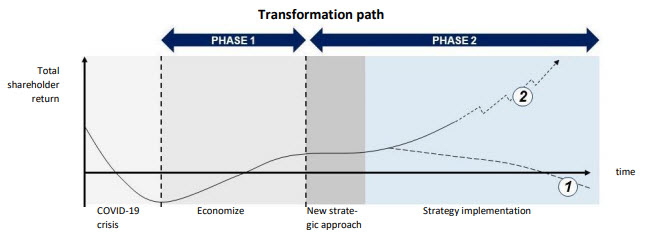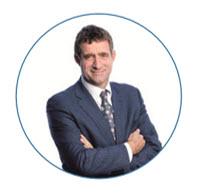The Post-COVID19 Era
Introduction
Most countries around the world are heavily affected by the COVID-19 crisis, with the number of infected people and deaths increasing rapidly. In Europe, this has resulted in different formats of Lockdowns across countries.
These Lockdowns will unavoidably lead to an economic depression. From the International Momentary Fund (IMF) we know that nonessential services closed by government decree account for about onethird of the output. This means that each month these sectors remain closed, the annual GDP will drop 3%, not taking into account other disruptions and spillovers to the rest of the economy.
On top this COVID-19 crisis, will also trigger a shift in beliefs and behaviors, impacting markets more broadly. It is hard to predict how it will shift, but it is plausible that we will see a greater focus on crisis readiness, system resilience, social solidarity, international interdependencies and availability- & access of healthcare. Furthermore, we should not expect consumers to shift only between existing products, but also to new ideas that will appear as a response to the COVID-19 crisis.
Do not waste a crisis
Leaders of organizations have the task to distinguish between temporary and more permanent changes in markets. One thing is sure, most markets will shrink as a result of the economies that turn into a depression. When the size of the markets will reduce, organizations will see the need for a transformation that will have a short term impact (survive) and a long term impact (growth). In the following diagram, the transformation of an organization is depicted:

COVID-19 crisis
The current period is characterized by shock, travel ban, remote working, digital collaboration and workplace hygiene. Depending of the type of business, organizations see their revenues shrinking or disappear. Depending on the length of this period of crisis organizations will realize the need for corrective actions to prevent heavy effects on their profit level.
Economize
In this phase, the focus will be on restoring the financial viability of the company and the creation of a plan for the journey back to growth. Painful cost cutting and other defensive measures in combination with strict planning are familiar approaches for staying afloat, although they are quick and obvious and deliver tangible results, they are not by themselves a recipe for long-term success. Economizing, without the launch of a new strategy focused on innovation and growth, will not be enough for long-term success. The guiding principal for the first phase of transformation should be to maximize immediate performance while preserving long term success options.
New strategic approach
The development of a new strategic approach will start with a key question: what will the new needs of our clients be and which consequences and opportunities does that offer us. For this approach, you need to develop a vision about the shift that will be triggered in your market, because of the changing needs of your clients. In order to spot emerging trends, a close follow up of market data can be helpful.
Based on this vision about the shift in the market, many organizations will need to innovate strategically and often make multiple fundamental changes to their business model. The challenge for leadership in this stage will be to persuasively communicate the new strategic approach, despite the fact that the company’s main focus is still on short term survival.
Strategy implementation
The implementation of the new strategic approach is a high-stake game that demands dedication of everyone involved in the organization. The biggest challenge is to make the step from economizing to growth once again. During the first phase, the organization is internally focused and approach tasks top down, in the second phase this approach has made a one-hundred-and-eighty-degree turn: the mindset is externally focused and working in line with the new strategic approach. The scenario of failure with implementing the new strategy is represented in the transformation with line one and successful implementation with line two.
Win or Lose
The success of a new strategic direction depends, besides on the ability to implement ,mainly on the ability of an organization to tune into the (future-) needs of clients. From previous experiences we have, while working with our clients, gathered four pieces of advice that contribute to success when an organization is going through a strategic transformation:
- Cut with courage: Economize rigorously in the first round, because different rounds of cost cutting can be demoralizing and create a situation in which a platform for a new strategy will be destroyed.
- Make a deliberate break with traditional ways of working: If you remain to operate as usual, you will prevent the organization from moving towards a mindset of renewal.
- Create a future perspective: communicate what the future looks like and which strategic priorities will contribute to that.
- Empowerment of non-leadership-level: during the implementation of the new strategic direction this empowerment will create the base for learning, increase flexibility and absorb
inevitable setbacks
You are not alone !
The key challenge of leaders in managing an organization through the transformation path is the opposing character of the two phases. The contradictions between the need of short term orientation, efficiency, discipline and clarity of direction in phase one, and, in phase two, the need to focus on long term orientation, innovation, growth, flexible adaption and empowerment, can make leadership a challenge.
However, you are not alone because we are able to support you and your organization with the following services:
- Definition and communication of your new strategic priorities,
- Measurement of your organizational culture, by using the organizational and traits scan from OCAI and give your team insight how to manage the culture during the two phases of the transformational path,
- Measure the leadership styles from your team members and provide them with reflection opportunities on how these styles relate to the transformation ahead and
- Coaching you and your team members through the transformational path.
Please do not hesitate to contact us if you would like to set up a (virtual) meeting!
About the Autor

Andre de Wit has more than 25 years of experience working for large corporate organizations. He worked as CEO of business units in IKEA and the Metro-group. He was the Vice President for Learning and Capability Building for the Metro-group and the Carlsberg-group for 6 years.

